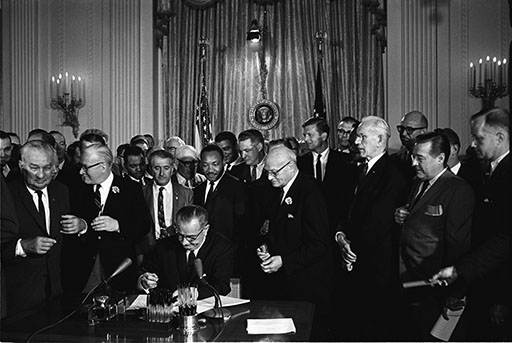6 The Civil Rights Act
This was followed by another victory for the civil rights movement the following month. Despite the personal resistance of the Alabama Governor George Wallace, two Black students – supported by the National Guard – were finally admitted to the University of Alabama, an institution that had previously been reserved only for White students. That evening, President Kennedy took a firm stance, delivering a speech on live television that denounced segregation and promised to take legislative action:
it ought to be possible … for American students of any color to attend any public institution they select without having to be backed up by troops. It ought to be possible for consumers of any color to receive equal service in places of public accommodation, such as hotels and restaurants and theaters and retail stores, without being forced to resort to demonstrations in the street, and it ought to be possible for American citizens of any color to register and vote in free elections without interference or fear of reprisal.
You can watch a video of the entire speech at YouTube.com [Tip: hold Ctrl and click a link to open it in a new tab. (Hide tip)] .
In order to fulfil this promise, the Kennedy administration began working on legislation that would end racial segregation and discrimination. The following month, on 28 August, Martin Luther King Jr. delivered what is considered one of the most famous speeches in the civil rights movement during a major civil rights march in Washington, D.C.:
I say to you today, my friends, so even though we face the difficulties of today and tomorrow, I still have a dream. It is a dream deeply rooted in the American dream. I have a dream that one day this nation will rise up and live out the true meaning of its creed: “We hold these truths to be self-evident, that all men are created equal”. I have a dream that one day on the red hills of Georgia, the sons of former slaves and the sons of former slave-owners will be able to sit down together at the table of brotherhood.
You can watch part of the speech in the video below:

Transcript: Video 3
[MUSIC PLAYING]
NARRATOR: The theme, the keynote, the thought uppermost in minds of all here today is best set forth by Dr. King. He sums up a day the capital will long remember.
DR MARTIN LUTHER KING: I have a dream that one day this nation will rise up, live out the true meaning of its creed. We hold these truths to be self-evident that all men are created equal.
I have a dream that one day on the red hills of Georgia sons of former slaves and the sons of former slave owners, will they be able to sit down together at the table of brotherhood. I have a dream.
NARRATOR: Washington, D.C. 1963. Democracy speaks in a mighty voice.
When King asserted that ‘we hold these truths to be self-evident, that all men are created equal’, he was consciously echoing the words of the 1776 Declaration of Independence, the adoption of which was a key moment in the American Revolution and the founding of the United States. In this sense, King was employing ‘revolutionary’ language, and it might be argued that he was indeed proposing a ‘revolution’ in race relations. King’s speech, like Kennedy’s television address, is now rightly seen as a significant moment in the civil rights movement. However, while it was an inspiring and powerful speech, it must be remembered that only limited progress had been made by this point. Despite small successes on a local level, attitudes on race remained largely unchanged, and substantial legislation to enforce racial integration had not yet been passed. Only three months after King’s speech, Kennedy was assassinated, before he could pass the civil rights bill through Congress.
Kennedy’s successor, Lyndon Johnson, was determined to finish his predecessor’s work and made passing the bill a priority. A significant number of southern senators, in particular, fiercely opposed the legislation, but in July 1964, after considerable debate in Congress, Johnson secured the passage of the Civil Rights Act. The Act outlawed race and colour discrimination, in addition to discrimination based on sex, religion or national origin. How radical was this legislation? In theory, the Act put an end to all forms of discrimination and segregation, but in reality, it did not do enough on its own to ensure this. As the historian John Robert Greene has stressed, ‘It was a landmark piece of legislation, but it was hardly the death-knell for either discrimination or segregation in the nation. It was, in short, a bill that Johnson could get passed’ (Greene, 2010, p. 56). For instance, although the Act outlawed school segregation, it did not guarantee that buses would be provided to transport Black students to schools previously reserved for White people, and it did not resolve discrimination in housing provision.

